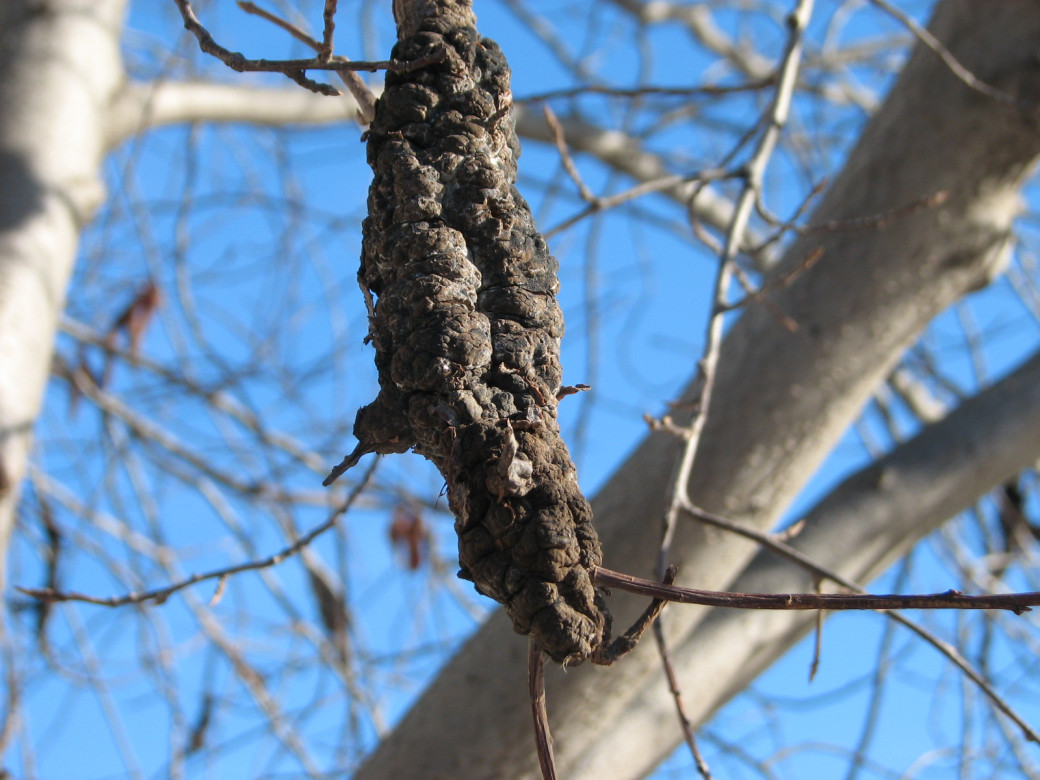What is Black Knot?
Black Knot, caused by the fungus Apiosporina morbosa, is a very common disease of plants in the genus Prunus (See Table 1). A survey in Alberta revealed a significant and widespread distribution of Black Knot found in commercial, municipal, private and natural plantings. This disease reduces the aesthetic value of affected specimens, as infections spread rapidly; high levels may result in the eventual death of the plant.
Table 1: Plant Species Affected by Black Knot
| Amur Cherry | Mayday Tree |
| Apricot | Mongolian Cherry |
| Black Cherry | Nanking Cherry |
| Chokecherry | Pin Cherry |
| Dropmore Cherry | Cultivated Plum |
| Flowering Almond | Wild Plum |
| Flowering Plum | Prunus Hybrids |
| Japanese Plum | Sand Cherry |
| Korean Cherry | Sour Cherry |
How can you recognize Black Knot?
The most distinguishing symptom of Black Knot is the characteristic black, tar-like swellings that develop on branches of the infected plant.

|

|
Photo Credit: Tricia Simon
Initially, a small, olive-green gall or swelling will develop at a succulent growing point or fruit spur (as a result of spores landing and infection taking place). This swelling will grow until it is mature after 2-3 years. The mature galls are hard, black, 10 to 15 cm (4 to 6 inches) and may be somewhat ruptured. Mature galls will produce and release a vast amount of spores during the bloom period, resulting in a rapid increase in infections. The fungus continues to grow internally and externally, with the branch eventually becoming girdled and dying.
What can be done to control Black Knot?
- Removal of sources of inoculum (prevents population build up)
- Prune out all knot-bearing branches during late fall, winter or very early spring when plants are dormant and knots are easy to see
- Remove infected branches to at least 15-20 cm (6-8 inches) below knot. NOTE: It is preferable to prune an infected branch further back to an appropriate location, such as a healthy collar, rather than leave a stub
- As a precaution, cutting blades should be cleaned and disinfected after pruning, if possible, especially if cuts have been made through obviously infected material
- For knots on scaffold branches or trunks that can't be removed, cut away diseased tissue down to good wood and at least 1 cm (1/2 inch) beyond the edge of the knot
- Failure to remove branches beyond the internal growth will result in re-growth of the fungus
- DISEASED WOOD MUST BE DESTROYED IMMEDIATELY (burned, buried or removed from site). Diseased knots can produce and release spores for up to 4 months after removal. Proper composting can help to accelerate the breakdown of infected materials
- Ensure plants are healthy and free from stress(not a guarantee from disease)
- Regular monitoring
- Ensure adequate canopy ventilation through proper pruning
- Chemical control (preventative not curative)
- Few choices available
- Not usually recommended unless for valuable plantings, such as collections, orchards, arboreta or for severe infestations
- Other options
- May include use of more resistant selections, ensuring adequate buffer zones between plantings and wild stock, or potential employing biological control products (limited)
- Consider hiring a trained professional for pruning activities (Find a Certified Arborist)
Additional References:
Black Knot of Plums
Tree Fruit and Berry Pathology
Horticulture Tips: Black Knot